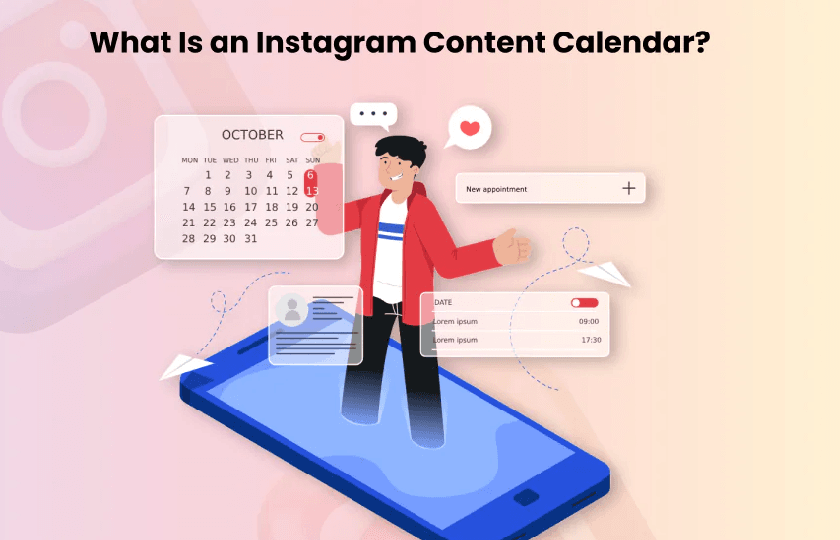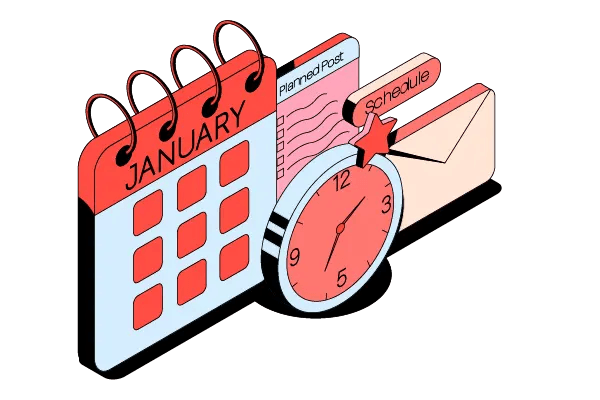In today’s fast-paced digital world, maintaining a consistent and engaging Instagram presence is crucial for personal brands, businesses, and influencers. However, creating compelling content regularly without a clear plan can be overwhelming. That’s where an Instagram content calendar comes in.
An Instagram content calendar is an essential tool that helps you organize and plan your posts in advance, ensuring that your content aligns with your marketing goals. This article will guide you through the process of creating an Instagram content calendar that will streamline your content creation, maximize engagement, and ultimately help you grow your followers and reach on the platform.
Table of Contents:
1.What is an Instagram Content Calendar?
2.Why You Need an Instagram Content Calendar
3.Benefits of Using a Content Calendar
4.How to Create Your Instagram Content Calendar
•Step 1: Define Your Goals
•Step 2: Understand Your Audience
•Step 3: Decide Content Types
•Step 4: Choose the Best Time to Post
•Step 5: Plan Themes and Campaigns
•Step 6: Map Out Your Content
5.Tools for Managing Your Instagram Content Calendar
6.How to Stay Consistent with Your Content Calendar
7.Analyzing Your Content Calendar’s Performance
8.Conclusion
1. What is an Instagram Content Calendar?
An Instagram content calendar is a planning tool that allows you to schedule your Instagram posts ahead of time. It includes crucial information such as the content type (photos, videos, carousels, Stories, etc.), captions, hashtags, and posting times. A content calendar allows you to map out your Instagram posts over a specific period, such as a week, month, or quarter.
A well-structured content calendar makes it easier for you to keep track of your posting schedule, ensure consistency, and avoid last-minute stress when creating content. The calendar serves as a roadmap, helping you maintain a strategic approach to content creation rather than posting impulsively or haphazardly.
2. Why You Need an Instagram Content Calendar
Having a content calendar is a game-changer when it comes to Instagram marketing. Below are some reasons why it’s essential for anyone who wants to succeed on the platform:
Maintain Consistency
Consistency is key to building a loyal Instagram following. Posting regularly and at the right times increases visibility and engagement. With a content calendar, you can schedule posts in advance, ensuring that you maintain a steady stream of content without missing any important dates.
Align Your Content with Business Goals
A content calendar ensures that your posts align with your overall business or personal brand strategy. You can plan content that directly supports your marketing goals, such as promoting products, highlighting special events, or engaging with your community.
Time-Saving
Creating content without a plan often leads to scrambling and rushing last-minute posts. A content calendar allows you to batch create your posts ahead of time, saving you time and reducing stress. This allows you to focus on other critical aspects of your business or personal brand.
Better Audience Engagement
With a content calendar, you can plan out different content types and themes that resonate with your audience. This ensures that your posts are varied and engaging, increasing the likelihood that your followers will interact with your content.
3. Benefits of Using a Content Calendar
Using an Instagram content calendar provides several advantages, which include:
Improved Content Strategy
By planning your content in advance, you can think strategically about the types of posts to create. This will help you stay aligned with your brand’s mission and values, ensuring that your posts deliver a consistent message.
Easier Collaboration
If you’re working with a team or external collaborators (e.g., photographers, designers, or influencers), having a content calendar makes collaboration easier. Everyone can stay on the same page, knowing exactly when each post will go live and what resources are needed.
Maximizing Reach
With a content calendar, you can plan posts around special dates, holidays, and key events that are relevant to your audience. By taking advantage of these events, you can boost your chances of getting more engagement and reaching a wider audience.
Tracking Performance
A content calendar enables you to track your performance over time. By analyzing which types of posts are performing well, you can tweak your content strategy for better results in the future.

4. How to Create Your Instagram Content Calendar
Creating an Instagram content calendar involves several key steps. Here’s a detailed breakdown of how to create one:
Step 1: Define Your Goals
Before creating your content calendar, it’s important to know your objectives. What do you want to achieve with your Instagram account? Your goals will help shape the type of content you post. Common Instagram goals include:
•Brand Awareness: If your goal is to build brand awareness, your content should focus on showcasing your products or services, brand story, and behind-the-scenes content.
•Engagement: If engagement is your priority, focus on creating interactive content, such as polls, quizzes, user-generated content, and comments that encourage conversation.
•Lead Generation: For lead generation, you should focus on content that drives traffic to your website, email list, or landing pages.
Understanding your goals will help you create content that aligns with your business objectives.
Step 2: Understand Your Audience
The next step is to understand your audience. Who are you creating content for? What type of content do they engage with? To answer these questions, you can:
•Use Instagram Insights: Instagram provides analytics tools to help you understand your followers’ demographics, including their age, gender, location, and the times they are most active.
•Conduct Surveys: You can also ask your audience directly what kind of content they enjoy by running polls or asking questions in your stories.
By understanding your audience’s preferences, you can create content that appeals to them and drives more engagement.
Step 3: Decide Content Types
Instagram offers various content types, and it’s important to include a mix to keep your feed dynamic and engaging. Some of the most popular content types include:
•Photos: High-quality, visually appealing images that showcase your products or lifestyle.
•Videos: Short-form or long-form videos that educate, entertain, or inform your audience.
•Carousels: Multi-image posts that can be used for tutorials, product showcases, or storytelling.
•Stories: Temporary posts that provide behind-the-scenes glimpses, promotions, or real-time updates.
•Reels: Short, engaging videos that can go viral and reach a wider audience.
Diversifying your content keeps your feed interesting and ensures that you cater to different types of users.
Step 4: Choose the Best Time to Post
Timing plays a significant role in the success of your Instagram posts. You should aim to post when your audience is most active. To find this information:
•Check Instagram Insights: Instagram shows the times when your followers are online.
•Experiment with Timing: If you’re unsure of the best times to post, experiment with posting at different times and days to track engagement.
Posting at the right time increases your chances of reaching your audience and boosting engagement.
Step 5: Plan Themes and Campaigns
A great way to organize your content is to plan around specific themes or campaigns. For example:
•Weekly Themes: Dedicate each day of the week to a specific type of content (e.g., #MotivationMonday, #ThrowbackThursday, #FeatureFriday).
•Monthly Campaigns: Create larger campaigns that align with product launches, seasonal promotions, or special events.
By planning these in advance, you ensure that your content stays organized and focused on your goals.

Step 6: Map Out Your Content
Now that you’ve defined your goals, audience, content types, and posting times, it’s time to map out your content. Use a calendar format to visualize when and what you will post each day.
Include the following details in your calendar:
•Post Date: The specific date and time when your post will go live.
•Content Type: Whether it’s a photo, video, carousel, or story.
•Caption: A draft of your post’s caption.
•Hashtags: Relevant hashtags to improve visibility.
•Call to Action: A CTA prompting your audience to like, comment, share, or click a link.
5. Tools for Managing Your Instagram Content Calendar
There are several tools available that can help you manage your Instagram content calendar. Some popular options include:
•Trello: A flexible tool for organizing your content and collaborating with your team.
•Google Calendar: Simple and effective for scheduling posts and reminders.
•Later: A tool specifically designed for social media scheduling, including Instagram.
•Hootsuite: A social media management tool that allows you to schedule posts, monitor engagement, and track performance.
Using these tools can help you stay on track and keep your content organized.
6. How to Stay Consistent with Your Content Calendar
Staying consistent with your content calendar is key to success. To do this:
•Batch Create Content: Set aside time each week or month to create content in bulk.
•Schedule Posts in Advance: Use scheduling tools to plan your posts ahead of time.
•Monitor and Adjust: Regularly check your content calendar and make adjustments based on what’s working and what’s not.
Consistency ensures that your content remains on schedule and aligns with your broader marketing strategy.
7. Analyzing Your Content Calendar’s Performance
To measure the success of your content calendar, analyze your Instagram performance regularly. Key metrics to track include:
•Engagement Rate: Likes, comments, shares, and saves.
•Reach and Impressions: The number of unique users who saw your content.
•Follower Growth: Track how your follower count increases over time.
By analyzing these metrics, you can refine your content strategy for better results.
Conclusion
Creating an Instagram content calendar is an essential step toward building a consistent and successful Instagram presence. By planning your content in advance, staying organized, and aligning your posts with your goals, you can increase engagement, grow your followers, and ensure that your content is always on-brand.
Whether you’re a business, influencer, or hobbyist, a content calendar will help streamline your Instagram marketing efforts and allow you to focus on creating meaningful content that resonates with your audience.



